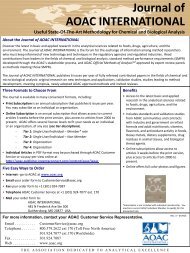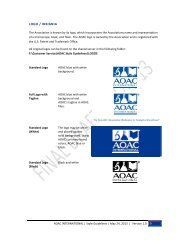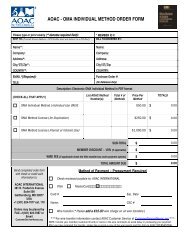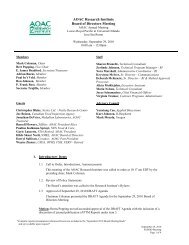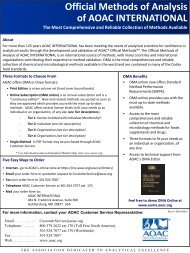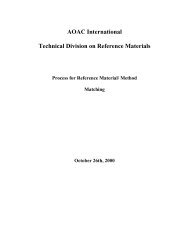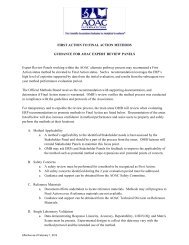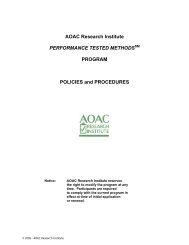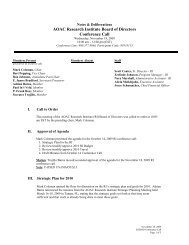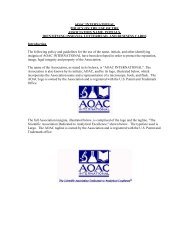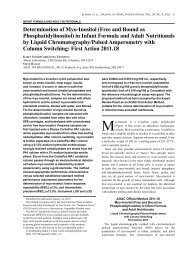Carotene In Supplements - AOAC International
Carotene In Supplements - AOAC International
Carotene In Supplements - AOAC International
Create successful ePaper yourself
Turn your PDF publications into a flip-book with our unique Google optimized e-Paper software.
1070 SCHIERLE ET AL.: JOURNAL OF <strong>AOAC</strong> INTERNATIONAL VOL. 87, NO. 5, 2004<br />
DIETARY SUPPLEMENTS<br />
Method for the Determination of �-<strong>Carotene</strong> in <strong>Supplements</strong> and<br />
Raw Materials by Reversed-Phase Liquid Chromatography:<br />
Single Laboratory Validation<br />
JOSEPH SCHIERLE, BERND PIETSCH, ALAN CERESA, and CHRISTIAN FIZET<br />
DSM Nutritional Products Ltd, Research and Development, Analytical Research Center, PO Box 3255, CH-4002 Basel,<br />
Switzerland<br />
EDWARD H. WAYSEK<br />
Caravan Products Co. <strong>In</strong>c., 100 Adams Dr, Totowa, NJ 07512<br />
A single laboratory validation (SLV) study was<br />
conducted for a liquid chromatography (LC)<br />
method for the determination of total and<br />
all-trans-�-carotene in a variety of dietary<br />
supplements, including multivitamin tablets,<br />
softgels, capsules, and beadlet raw materials.<br />
Extraction variants were developed for the different<br />
types of supplements tested based upon the<br />
supplement type and level of �-carotene. Water<br />
dispersible formulations such as powders,<br />
emulsions, tablets, and capsules were<br />
enzymatically digested with protease and extracted<br />
with dichloromethane–ethanol. Oily suspensions<br />
were directly dissolved in dichloromethane–<br />
ethanol. After appropriate dilution or<br />
concentration, the extracts were chromatographed<br />
by using either a reversed-phase C18 column or, in<br />
products containing high amounts of �-carotene, a<br />
reversed-phase C30 column. The LC systems<br />
provided linear responses in the range of 0.1–50 �g<br />
�-carotene/mL. The main geometrical isomers of<br />
�-carotene (all-trans, 9-cis, 13-cis, and 15-cis) were<br />
well separated from each other and from other<br />
carotenoids such as �-carotene, cryptoxanthin, lutein,<br />
lycopene, and zeaxanthin. Duplicate determinations<br />
of total �-carotene performed by 2 technicians in 8<br />
different test materials on 5 different days resulted<br />
in relative standard deviations of 1.2–4.4%.<br />
Recoveries determined for supplements and<br />
beadlet raw material spiked with �-carotene levels<br />
of 10 �g to 100 mg/test portion and 0.2–40%,<br />
respectively, ranged from 97.5 to 102.1%. On the<br />
basis of the accuracy, precision, and recovery<br />
results from the SLV study, the method is<br />
suggested for a collaborative study on the<br />
determination of total and all-trans-�-carotene in<br />
dietary supplements.<br />
Received January 30, 2004. Accepted by AP July 28, 2004.<br />
Corresponding author's e-mail: Joseph.Schierle@dsm.com.<br />
�-carotene is generally regarded as the most commercially<br />
important and widely used carotenoid. It is used as a food<br />
coloring agent, an antioxidant, and an important and safe<br />
pro-vitamin A source (1–3). �-carotene is currently incorporated<br />
in a wide variety of dietary supplements, including multivitamin,<br />
vitamin A, and antioxidant formulations. Recently, additional<br />
carotenoids, including lutein and lycopene, have been the subject<br />
of nutritional studies and are now also incorporated, both in<br />
combination products and in dietary supplements available to the<br />
general public. Spectrophotometry is still a common technique<br />
for the analysis of �-carotene in commercial product forms.<br />
Schierle et al. (4) reported a spectrophotometric procedure for the<br />
determination of total �-carotene in food additives with varying<br />
cis-/trans-ratios using an isobestic wavelength. However,<br />
spectrophotometric methods cannot differentiate between<br />
all-trans-�-carotene and cis-isomers of �-carotene, which may<br />
be formed during processing (5–12). Spectrophotometric<br />
analytical procedures are also not capable of determining<br />
�-carotene in combination products containing other carotenoids<br />
such as �-carotene, lutein, or lycopene. �-carotene and carotenoids<br />
in general have been intensively studied by liquid chromatography<br />
(LC), and procedures have been reported for the separation of<br />
�-carotene cis-/trans-isomers (13–18) and for �-carotene in<br />
supplements and foods (19, 20). Thus, a chromatographic<br />
procedure capable of separating all-trans-�-carotene from the<br />
corresponding cis-isomers and from other commercially used<br />
carotenoids was deemed necessary to properly determine the<br />
�-carotene content in dietary supplements.<br />
METHOD<br />
Test and Negative Control Materials<br />
(a) Test materials.—Dietary supplements test materials<br />
used in the study were chosen to represent the range of dietary<br />
supplements containing �-carotene currently available to the<br />
general public and included the following (1000 IU<br />
�-carotene = 0.6 mg �-carotene; 21):<br />
(1) Multivitamin tablets; claim: vitamin A 3500 IU, 29%<br />
as �-carotene.<br />
(2) Softgels with �-carotene in soybean oil; claim:<br />
�-carotene 25 000 IU.
(3) Capsules with �-carotene in fish oil; no claim for<br />
�-carotene.<br />
(4) Softgels with �-carotene from carrot oil extract; claim:<br />
vitamin A (as �-carotene) 10 000 IU.<br />
(5) Tablets with �-carotene; claim: 25 mg �-carotene.<br />
(6) Capsules with �-carotene; claim 6 mg �-carotene.<br />
(7) Softgels with vitamin A (as �-carotene) and vitamin E;<br />
claim: vitamin A 25 000 IU (as �-carotene).<br />
(8) Beadlets raw material with pure �-carotene; claim:<br />
20% �-carotene.<br />
(b) Negative control materials.—<br />
(1) Placebo multivitamin tablets, Reference No.<br />
81.16.03.32 (DSM Formula No. 80.23) containing vitamin A<br />
acetate, vitamin D 3, vitamin E, ascorbic acid, thiamin<br />
mononitrate, vitamin B 2, nicotinamide, pyridoxine HCl,<br />
vitamin B 12, folic acid, pantothenic acid, biotin, vitamin K 1,<br />
iron fumarate, magnesium oxide, potassium iodide, zinc<br />
sulfate monohydrate, manganese sulfate monohydrate, copper<br />
sulfate anhydrous, chromium chloride hexahydrate, sodium<br />
selenite anhydrous, sodium molybdate dihydrate, calcium<br />
phosphate anhydrous, potassium chloride, silicon dioxide,<br />
cellulose, stearic acid, magnesium stearate,<br />
n-vinyl-2-pyrollidone. Coated with Sepifilm LP014 and<br />
Sepifilm 6097 Red (Seppic, <strong>In</strong>c., Fairfield, NJ).<br />
(2) Lycopene 10% WS (water soluble) placebo beadlets,<br />
Lot UT02071003 32, containing fish gelatin, saccharose,<br />
vitamin C palmitate, maize oil, DL-�-tocopherol, water.<br />
Test materials for dietary supplements were obtained from<br />
commercial sources and provided by <strong>AOAC</strong><br />
INTERNATIONAL. �-carotene beadlets, reference materials,<br />
and the negative control materials were provided by DSM<br />
SCHIERLE ET AL.: JOURNAL OF <strong>AOAC</strong> INTERNATIONAL VOL. 87, NO. 5, 2004 1071<br />
Figure 1. The predominant geometrical isomers of �-carotene: all-trans-�-carotene, 9-cis-�-carotene,<br />
13-cis-�-carotene, and 15-cis-�-carotene.<br />
Nutritional Products (Basel, Switzerland). Test and negative<br />
control materials were stored at 5�C in the dark (refrigerator).<br />
Principle<br />
Water-dispersible formulations such as powders,<br />
emulsions, tablets, and capsules are digested with protease<br />
and extracted with dichloromethane and alcohol. Oily<br />
suspensions are dissolved directly in dichloromethane and<br />
alcohol. The extract is chromatographed on a C18 isocratic<br />
LC system that separates the predominant geometrical<br />
isomers of �-carotene from each other (Figure 1) and from<br />
other carotenoids such as all-trans-�-carotene, lycopene,<br />
Table 1. Dilutions and concentrations<br />
Solution to be diluted, �g/mL Dilution<br />
Final concentration,<br />
�g/mL<br />
100 1 + 1 50<br />
100 1 + 4 20<br />
100 1 + 9 10<br />
50 1 + 9 5<br />
20 1 + 9 2<br />
10 1 + 9 1<br />
5 1 + 9 0.5<br />
2 1 + 9 0.2<br />
1 1 + 9 0.1<br />
0.5 1 + 9 0.05
1072 SCHIERLE ET AL.: JOURNAL OF <strong>AOAC</strong> INTERNATIONAL VOL. 87, NO. 5, 2004<br />
Table 2. Method precision for measurement of total and all-trans-�-carotene in test materials Nos. 1–8 a<br />
Test material No.<br />
cryptoxanthin, lutein, and zeaxanthin. <strong>In</strong> the case of products<br />
with relatively high �-carotene content, the cis-isomers of<br />
�-carotene can interfere. <strong>In</strong> this case, the extract is also<br />
chromatographed with a more selective but longer running<br />
C30 reversed-phase LC system that avoids this interference.<br />
Scope<br />
The method is suitable for the determination of all-trans<br />
and total �-carotene. The term total �-carotene comprises<br />
all-trans-�-carotene and all other compounds identified as<br />
cis-isomers of �-carotene. The method is applicable to the<br />
determination of 0.01 mg or greater of total �-carotene in<br />
tablets, capsules, and >0.2% �-carotene in oily or<br />
water-dispersible raw materials in the presence of other<br />
carotenoids such as lycopene, �-carotene, and xanthophylls.<br />
Apparatus<br />
Extraction<br />
variant<br />
LC<br />
system<br />
(a) Balances.—With readability of 0.01 mg, precision<br />
[standard deviation (SD)] of �0.015 mg, capacity 205 g<br />
(AT261 DeltaRange; Mettler-Toledo, N�nikon-Uster,<br />
Switzerland); with readability of 0.01 g, precision (SD) of<br />
� 0.005 g, capacity 2100 g (PM2000; Mettler-Toledo).<br />
(b) Spectrophotometer.—Dual beam, wavelength range of<br />
190–900 nm, 1.5 nm fixed spectral bandwidth, wavelength<br />
accuracy of 0.07 nm (at 541.92 nm), wavelength<br />
reproducibility of 0.01 nm (Cary 50 Scan; Varian, Darmstadt,<br />
Germany).<br />
(c) Ultrasonic water bath.—150 W, 35 kHz, 4 L<br />
(TUC-160; Telsonic, Bronschhofen, Switzerland).<br />
(d) Rotary evaporator.—5–240 rpm, 20�–100�C<br />
(Rotavapor R-114, water bath R-480; Büchi Labortechnik,<br />
Flawil, Switzerland), connected to a vacuum pump with<br />
absolute minimum pressure of 10 mbar (PC 5; Vacuubrand,<br />
Wertheim, Germany).<br />
Total �-carotene, mg/g All-trans-�-carotene, mg/g<br />
Mean value,<br />
n = 10 RSD, %<br />
(e) Homogenizer.—750 W, 12 mm diameter dispersing<br />
aggregate [Polytron PT3100 (drive unit), PT-DA-3012/2T<br />
(aggregate); Kinematica, Lucerne, Switzerland].<br />
(f) Syringe.—Disposable, 2 mL (Henke-Sass, Wolf<br />
GmbH, Tuttlingen, Germany).<br />
(g) Filter.—Disposable, 0.45 �m pore size, 25 mm<br />
diameter, for organic solvents (Chromafil Type O-45/25;<br />
Machery-Nagel, Düren, Germany); 0.45 �m pore size, for<br />
organic solvents (Millipore, Bedford, MA; Type DVPP, 5 mm<br />
diameter).<br />
(h) LC system.—Consisting of online degasser (154,<br />
Gastorr; Omnilab, Mettmenstetten, Switzerland); gradient<br />
pump (L6200; Merck-VWR, Dietikon, Switzerland);<br />
autosampler with cooling unit (AS-1559; Jasco, available<br />
from Omnilab); column thermostat (Jetstream 2 Plus;<br />
Thermotechnic Products, A-2103 Langenzersdorf, Austria);<br />
UV-Vis detector (Jasco PU-2070 Plus, available from<br />
Omnilab); integrator (ATLAS� Chromatography Data<br />
System; Thermo LabSystems, Manchester, UK, combined<br />
with Microsoft � Windows 2000 Terminal Server, Citrix<br />
MetaFrame).<br />
(i) Suplex PKB-100 LC column.—5 �m, 250 � 4.6 mm,<br />
Cat. No. 58934 (Supelco, Bellefonte, PA).<br />
(j) YMC-Pack C30 LC column.—5 �m, 250 � 4.6 mm,<br />
Product Code CT99S052546WT, available, e.g., from<br />
Stagroma (Wallisellen, Switzerland).<br />
Reagents<br />
Mean value,<br />
n = 10 RSD, %<br />
Multivitamin tablets (1) c,2 A 0.494 2.4 0.428 3.5<br />
Softgels with �-carotene in soybean oil (2) c,3 A 47.1 1.5 45.2 1.4<br />
Capsules with �-carotene in fish oil (3) c,1 b<br />
B 0.0520 3.1 0.0310 4.6<br />
Softgels with �-carotene from carrot oil extract (4) c,3 B 9.64 2.2 6.62 2.4<br />
Tablets with �-carotene (5) d,3 b<br />
Capsules with �-carotene (6a) d,2 b<br />
A 49.3 2.6 39.2 3.0<br />
A 23.7 10.4 22.8 10.4<br />
Capsules with �-carotene (6b) c,3 A 26.2 1.2 25.1 1.2<br />
Capsules with �-carotene (7) c,3 B 32.2 4.4 23 5.4<br />
Beadlets raw material with pure �-carotene (8) b A 201 1.3 160 2.0<br />
a Analyses were performed in duplicate by 2 technicians on 5 different days.<br />
b Only for validation purpose (analytical method prescribes other variants for these test materials).<br />
All chemicals and solvents were analytical grade unless<br />
otherwise specified.<br />
(a) Chemicals.—Butylated hydroxytoluene (BHT,<br />
2,6-di-tert-butyl-p-cresol): Purity �99% (Fluka purum grade);<br />
N-ethyldiisopropylamine: purity �98% (GC; Fluka purum<br />
grade).
Table 3. Isomerization of �-carotene during extraction procedure<br />
(b) Solvents.—Acetonitrile: purity �99.9% (Merck LC<br />
grade); tert-butyl methyl ether (tBME): purity �99.5% (Fluka<br />
puriss grade); water: demineralized.<br />
(c) Protex 6L.—Bacterial alkaline protease enzyme<br />
preparation in water. Synonyms: subtilisin, IUB 3.4.21.62,<br />
CAS 9014-01-1. EINECS 2327522, available from Genencor<br />
<strong>In</strong>ternational, <strong>In</strong>c. (Palo Alto, CA; www.genencor.com).<br />
(d) Ammonium acetate solution 0.2%.—Dissolve 0.50 g<br />
ammonium acetate in 250 mL water. Store solution at 5�C for<br />
no longer than 1 month.<br />
(e) Mobile phase A.—<strong>In</strong> 1 L volumetric flask, dissolve<br />
50 mg BHT in 20 mL 2-propanol and add 0.2 mL<br />
N-ethyldiisopropylamine, 25 mL 0.2% ammonium acetate<br />
solution, 455 mL acetonitrile, and ca 450 mL methanol.<br />
Mixture cools and contracts. Let warm to room temperature<br />
and dilute to volume with methanol. Discard after 2 days.<br />
(f) Mobile phase B.—<strong>In</strong> 1 L volumetric flask, dissolve<br />
100 mg vitamin C in ca 100 mL methanol (sonicate), add<br />
100 mL tBME, and dilute to volume with methanol. Discard<br />
after 2 days.<br />
(g) �-carotene reference substance.—�-carotene, C 40H 56,<br />
FW 536.9, CAS 7235-40-7, purity �95% (LC), available<br />
under Product Code 11045800 from Dr. Ehrenstorfer GmbH<br />
(Augsburg, Germany). Store under argon or nitrogen in a cool<br />
dark place. The compound deteriorates in the presence of<br />
oxygen.<br />
(h) Other carotenoids reference substances.—All-trans-lutein,<br />
all-trans-zeaxanthin, all-trans-�-cryptoxanthin, all-trans-lycopene,<br />
all-trans-�-carotene, all-trans-�-carotene�, and 9-cis-, 13-cis-,<br />
15-cis-, 9,9�-di-cis, 9,15-di-cis-, 13,15-di-cis-�-carotene were<br />
synthesized at DSM Nutritional Products.<br />
Calibration<br />
Protect solutions from direct sun or UV light.<br />
(a) Standard solutions.—3 �g/mL �-carotene. Weigh with<br />
an accuracy of 0.01 mg ca 6 mg all-trans-�-carotene reference<br />
material into 100 mL volumetric flask, dissolve in about<br />
20 mL tetrahydrofuran by treating in an ultrasonic bath for<br />
about 30 s. Dilute to volume with tetrahydrofuran (60 �g/mL).<br />
From this standard stock solution, pipet exactly aliquots of 5<br />
mL into two 100 mL volumetric flasks. Dilute to volume with<br />
cyclohexane in one flask [standard measuring solution,<br />
3 �g/mL �-carotene in cyclohexane–tetrahydrofuran (95 +<br />
5)]. Pipet 5 mL tetrahydrofuran into the other flask and dilute<br />
SCHIERLE ET AL.: JOURNAL OF <strong>AOAC</strong> INTERNATIONAL VOL. 87, NO. 5, 2004 1073<br />
Percentage of �-carotene isomers, % a<br />
Direct After extraction<br />
Sample All-trans 9-cis 13-cis 15-cis All-trans 9-cis 13-cis 15-cis<br />
Almost pure all-trans-�-carotene 97.2 0.7 2.2 — 97.4 0.8 1.9 —<br />
Heat-isomerization �-carotene 73.0 1.1 23.4 2.5 72.6 1.6 24.0 1.8<br />
a Total �-carotene = 100%.<br />
to volume with ethanol [standard working solution, 3 �g/mL<br />
�-carotene in ethanol–tetrahydrofuran (9 + 1)]. Store standard<br />
stock, measuring and working solutions at 5�C and use only<br />
on day of preparation.<br />
(b) Spectrophotometry.—Measure absorption of the<br />
standard measuring solution against cyclohexane at the<br />
maximum, ca 456 nm. Calculate concentration of �-carotene,<br />
C std, as follows:<br />
C std (mg/L) = E � 10 000/2500<br />
here E is the absorption at the maximum, 2500 is the E 1%,1cm of<br />
pure all-trans-�-carotene in cyclohexane, and 10 000 is the<br />
factor to convert % to mg/L.<br />
Calculate the apparent E 1%,1cm of the reference substance<br />
(ap E 1%,1cm) used to prepare the standard solutions as follows:<br />
Apparent E 1%,1cm = E � 10 000 � 2/W<br />
where E is the absorption at the maximum, 10 000 is the factor<br />
to convert mg/L to %, 2 is the theoretical volume (in L) in hich<br />
the reference substance is dissolved, and W is the weight of<br />
Figure 2. LC system A chromatogram of an isomeric<br />
mixture of �-carotene as present in many supplements.<br />
BCA: �-carotene.
1074 SCHIERLE ET AL.: JOURNAL OF <strong>AOAC</strong> INTERNATIONAL VOL. 87, NO. 5, 2004<br />
Figure 3. Chromatogram of test material No. 4 (Nature's Plus, Octa-carotene) obtained with LC system A. ACA:<br />
�-carotene; BCA: �-carotene.<br />
Figure 4. Chromatogram of test sample No. 4 (Nature's Plus, Octa-carotene) obtained with LC system B. ACA:<br />
�-carotene; BCA: �-carotene.
the reference substance (in mg). The apparent E 1%,1cm must<br />
exceed 2375 for a spectrophotometric purity >95%.<br />
(c) LC of standard solution.—<strong>In</strong>ject at least 6 aliquots of<br />
20 �L of the standard working solution, (a), immediately after<br />
preparation into the LC system. Calculate the response factor<br />
of all-trans-�-carotene from the averaged total peak areas of<br />
the chromatograms and the spectrophotometrically measured<br />
�-carotene concentration as<br />
RF trans [AU � L/mg] = A std/C std<br />
where RF trans is the response factor of all-trans-�-carotene,<br />
A std is the mean total peak area of the standard chromatograms<br />
(Area Units, AU), and C std is the spectrophotometrically<br />
measured �-carotene concentration of the standard measuring<br />
solution [mg/L]. The peak area of all-trans-�-carotene must<br />
exceed 95% of the total peak area (i.e., chromatographic<br />
purity is >95%).<br />
(d) LC response of control solutions.—Control solutions<br />
are solutions of heat isomerized �-carotene, concentrations of<br />
which have been found to be stable at 5�C for at least 3<br />
months in the dark. It is not necessary to recalibrate the LC<br />
system if the previous response factor has been shown to be<br />
valid by use of control solutions.<br />
(1) Preparation of the LC control solution.—Dissolve<br />
about 3 mg �-carotene reference substance and 1 g BHT in<br />
50 mL tetrahydrofuran. Add 200 mL ethanol and reflux for 2 h<br />
in a water bath at 80�C. Cool, dilute to 500 mL with ethanol,<br />
and transfer solution to a dispenser bottle. Mix well, leave<br />
overnight at room temperature, and dispense solution into a<br />
large number of LC vials. Carefully seal the vials immediately<br />
after filling with Teflon/silicone septa, and store at ca 5�C in<br />
the dark.<br />
SCHIERLE ET AL.: JOURNAL OF <strong>AOAC</strong> INTERNATIONAL VOL. 87, NO. 5, 2004 1075<br />
Table 4. Total and all-trans-�-carotene in test materials Nos. 1–8 measured by LC systems A and B<br />
Test material (No.)<br />
LC<br />
system A<br />
Total-�-carotene, mg/dose All-trans-�-carotene, mg/dose<br />
LC<br />
system B Difference, % a<br />
Multivitamin tablets (1) 0.725 0.743 2.5 0.625<br />
(2) Use of the LC control solution.—Measure the initial<br />
total �-carotene content of the control solution when the LC<br />
system is calibrated. <strong>In</strong>ject in parallel with the standard<br />
solution, at least 6 aliquots of 20 �L into the LC system.<br />
Calculate the mean �-carotene content of the control solution<br />
from the resulting chromatograms using the newly determined<br />
response factor. Subsequently inject the control solution<br />
together with each series of test extracts. The response factor<br />
is regarded as constant as long as the measured total<br />
�-carotene content of the control solution corresponds to the<br />
initial value within �2%��As long as the response factor<br />
remains within these limits, the original response factor can be<br />
used for calculations. However, the LC system must be<br />
recalibrated if the measured total��-carotene content exceeds<br />
the tolerance.<br />
(3) Linearity of the LC response.—Dissolve 10 mg<br />
all-trans-�-carotene in 5 mL dichloromethane in 100 mL<br />
volumetric flask. Add 50 mL ethanol and reflux at 80�C in<br />
water bath for 2 h. Add ca 40 mL dichloromethane, bring to<br />
room temperature, and dilute to volume with<br />
dichloromethane. Dilute solution (100 �g/mL) with mixed<br />
solvent as shown in Table 1 to obtain �-carotene<br />
concentrations of 100–0.05 �g/mL.<br />
<strong>In</strong>ject solutions into the LC system and calculate the<br />
�-carotene content as in Calculations. The response must be<br />
linear for �-carotene concentrations of 0.1–50 �g/mL with a<br />
determination coefficient R 2 > 0.995, and the back calculated<br />
concentration is within the target of �10% of theoretical.<br />
Sample Preparation<br />
LC LC<br />
system A system B Difference, % a<br />
0.62<br />
9 0.5<br />
Softgels with �-carotene in soybean oil (2) 15.9 16.00 0.8 15.2 15.3 0.9<br />
Capsules with �-carotene in fish oil (3)<br />
0.0<br />
599 0.0599 0.0<br />
0.037<br />
0<br />
0.0<br />
364 –1.5<br />
Softgels with �-carotene from carrot oil extract (4) 6.83 6.31 –7.7 4.85 4.36 –10.0<br />
Tablets with �-carotene (5) 24.6 25.1 2.4 19.5 19.5 –0.4<br />
Capsules with �-carotene (6) 6.82 6.81 –0.0 6.53 6.53 0.0<br />
Capsules with �-carotene, claim 25 mg �-carotene<br />
(7) 20.7 20.9 1.2 14.9 15.0 0.6<br />
Beadlets raw material with pure �-carotene (8) b<br />
a Results fo rLC system A = 100%.<br />
b Unit is g/kg instead of mg/dose.<br />
199 205 3.2<br />
157<br />
158 0.7<br />
Sample preparation is dependent on the physical form of<br />
the material, the claimed content of �-carotene, and the weight<br />
of the dosage form.
1076 SCHIERLE ET AL.: JOURNAL OF <strong>AOAC</strong> INTERNATIONAL VOL. 87, NO. 5, 2004<br />
Table 5. Peak area ratios of �-carotene isomers in eluents of LC-systems A and B of the present method compared<br />
with earlier LC system (25)<br />
(a) Mean weight per dose.—Weigh 20 tablets or capsules<br />
and calculate the mean weight, W D. Use the mean weight to<br />
calculate the �-carotene content of test material.<br />
(b) Number of tablets or capsules per assay.—For content<br />
uniformity tests, take 1 tablet or the content of 1 capsule for<br />
each assay and perform 10 assays in parallel. Report<br />
individual results. For determination of the mean �-carotene<br />
content, take equivalent of content of 3 tablets or capsules for<br />
each assay and conduct 2 assays in parallel. Report the<br />
averaged result of the 2 assays.<br />
(c) Preparation of test sample.—Homogenize<br />
suspensions or emulsions by intensive stirring, e.g., with a<br />
glass rod. Crush tablets to a powder by grinding a tablet placed<br />
between the 2 halves of a folded weighing paper with a pestle.<br />
Empty capsules containing powder formulations and extract<br />
powder together with capsule shells. Use capsules containing<br />
liquid formulations as such.<br />
Extraction<br />
Eluent of LC system published earlier a 445<br />
nm, 0.8 mL/min<br />
Protect extracts and solutions from direct sun or UV light.<br />
(a) Oily solutions or suspensions.—Accurately weigh test<br />
portion equivalent to ca 20 mg �-carotene, add 250 mg BHT,<br />
and rinse into 250 mL volumetric flask with 120 mL<br />
dichloromethane. Add 100 mL ethanol, and shake. Mixture<br />
cools and contracts. Let stand in dark until room temperature<br />
is reached (ca 2 h), dilute to volume with dichloromethane,<br />
and shake vigorously. Dilute aliquot in ratio of 1 + 9 with<br />
dichloromethane–ethanol (1 + 1) in volumetric flask, e.g., 5 to<br />
Eluent of LC system A,<br />
448 nm, 0.6 mL/min<br />
Sample Peak areas b cis/trans ratio Peak areas b cis/trans ratio<br />
All-trans-�-carotene 1209 ± 21 — 902 ± 15 —<br />
9-cis-�-carotene 1241 ± 4 1.03 925 ± 7 1.03<br />
13-cis-�-carotene 375 ± 19 0.31 281 ± 9 0.31<br />
15-cis-�-carotene 774 ± 25 0.64 573 ± 8 0.64<br />
Eluent of LC system published earlier a<br />
445 nm, 0.8 mL/min<br />
Eluent of LC system B,<br />
445 nm 0.4 mL/min c<br />
Peak areas b cis/trans ratio Peak areas b cis/trans ratio<br />
All-trans-�-carotene 546 ± 2 — 1083 ± 3 —<br />
9-cis-�-carotene 560 ± 4 1.03 1115 ± 1 1.03<br />
13-cis-�-carotene 447 ± 1 0.82 881 ± 4 0.81<br />
15-cis-�-carotene 390 ± 2 0.71 774 ± 1 0.72<br />
a Methanol–THF (99 + 1), 100 ppm vitamin C (25).<br />
b Mean and standard deviation from 4 injections.<br />
c Flow rate was sent to a 0.4 mL/min for better separation of isomers.<br />
50 mL. If necessary, filter the solutions through a 0.45 �m<br />
membrane. <strong>In</strong>ject 20 �L into LC system.<br />
(b) Powders, beadlets, or emulsions.—Accurately weigh<br />
test portion equivalent to about 10 mg �-carotene into 250 mL<br />
volumetric flask. Add 250 mg BHT, 0.5 mL Protex 6L, and<br />
15 mL water. Sway to wet contents and place in ultrasonic<br />
bath at ca 50�C for 30 min, swirling after about 15 min. Add<br />
100 mL ethanol to the warm suspension and shake vigorously.<br />
Add 135 mL dichloromethane, and shake again. Mixture<br />
cools and contracts. Let stand in dark until room temperature<br />
is reached (ca 2 h), dilute to volume with dichloromethane,<br />
shake vigorously, and let solids settle. Dilute an aliquot of the<br />
supernatant in a ratio of 1 + 9 with dichloromethane–ethanol<br />
(1 + 1) in a volumetric flask, e.g., 5 to 50 mL. If necessary<br />
filter the solutions through 0.45 �m membrane. <strong>In</strong>ject 20 �L<br />
into LC system.<br />
(c) Tablets and capsules with test portion mass<br />
Table 6. Recovery of different extraction variants<br />
Extraction<br />
variant<br />
(ca 2 h), dilute to volume with dichloromethane, shake<br />
vigorously, and let solids settle. Proceed as follows:<br />
(1) �-carotene content of the test portion 10 mg.—Dilute<br />
aliquot of supernatant with dichloromethane–ethanol (1 + 1)<br />
so that �-carotene content of final solution is between 1 and<br />
10 �g/mL. Filter solutions through 0.45 �m membrane, if<br />
necessary, and inject 20 �L into LC system.<br />
(d) Tablets with mass of test portion >5 g.—Accurately<br />
weigh test portions of 1–3 tablets prepared as in Sample<br />
Preparation (c), into weighed 100 mL volumetric flask. Add<br />
1 g BHT, 1 mL Protex 6L, and 40 mL water. <strong>In</strong> the case of<br />
effervescent tablets, add water slowly and in small portions to<br />
avoid foaming over and wait for the next step until all gas has<br />
been released. Shaking and adding a few droplets of ethanol<br />
help to repress foaming. Place in ultrasonic bath at ca 50�C for<br />
30 min, swirling after about 15 min. Add 50 mL ethanol to the<br />
warm suspension, let cool to room temperature, and dilute to<br />
volume with water. Weigh flask and contents. Shake<br />
vigorously and immediately pour 8–12 g suspension into a<br />
tared 100 mL volumetric flask using a funnel. Weigh the<br />
transferred aliquot of the suspension. Add 35 mL ethanol and<br />
shake. Add 35 mL dichloromethane and shake again. If<br />
clumps form, homogenize with rotation homogenizer, rinse<br />
with 15 mL dichloromethane, combining rinse with contents<br />
of volumetric flask. Mixture cools and contracts. Let stand in<br />
dark until room temperature is reached (ca 2 h), dilute to<br />
SCHIERLE ET AL.: JOURNAL OF <strong>AOAC</strong> INTERNATIONAL VOL. 87, NO. 5, 2004 1077<br />
Spiked total �-carotene, a mg/g Recovered total �-carotene, mg/g<br />
Negative control<br />
material No. Mean RSD, % (n = 3) Mean RSD, % (n = 3) Recovery, % b<br />
b 2 2.05 0.5 2.04 1.5 99.7<br />
b 2 398 0.5 396 0.3 99.5<br />
c,1 1 0.00876 2.1 0.00854 7.6 97.5<br />
c,2 1 1.023 0.5 0.999 1.2 97.6<br />
c,3 1 99.5 0.5 100.5 1.1 101.1<br />
d,1 1 0.00983 0.8 0.00996 4.3 101.3<br />
d,2 1 0.995 0.7 0.983 2.3 98.8<br />
d,3 1 99.5 0.5 101.6 2.0 102.1<br />
a Concentration determined after appropriate dilution of spiking solution.<br />
b Relative to amount of spiked total-�-carotene (= 100%).<br />
volume with dichloromethane, shake vigorously, and let<br />
solids settle. Proceed as follows:<br />
(1) �-carotene content of the test portion<br />
50<br />
mg.—Dilute aliquot of supernatant with<br />
dichloromethane–ethanol (1 + 1) so that �-carotene content of<br />
final solution is between 1 and 10 �g/mL. Filter the solutions<br />
through 0.45 �m membrane, if necessary, and inject 20 �L<br />
into LC system.<br />
Chromatography<br />
Test solutions are first injected into LC system A involving<br />
a C18 column. <strong>In</strong> this system, cis-isomers of �-carotene can<br />
interfere with the trans- and cis-isomers of �-carotene. If in<br />
chromatograms of LC system A, the peak area of<br />
all-trans-�-carotene exceeds the total peak area of �-carotene<br />
isomers by >5%, the test solution is analyzed by the more<br />
selective LC system B.<br />
(a) LC system A.—(1) Conditions.—Column: Suplex<br />
pKb-100; column temperature 30�C; mobile phase A (see<br />
Reagents); flow rate 0.6 mL/min; pressure ca 33 bar; run time<br />
ca 30 min; injection volume 20 �L; autosampler temperature<br />
15�C; detection at 448 nm. (2) Retention<br />
times.—All-trans-�-carotene: ca 20–25 min. Retention times<br />
relative to all-trans-�-carotene: all-trans-lutein 0.30;<br />
all-trans-zeaxanthin 0.32; all-trans-�-cryptoxanthin 0.58;<br />
all-trans-lycopene 0.67; nonidentified cis-lycopenes 0.69,
1078 SCHIERLE ET AL.: JOURNAL OF <strong>AOAC</strong> INTERNATIONAL VOL. 87, NO. 5, 2004<br />
0.75, 0.79; 9�-cis-�-carotene 0.91; all-trans-�-carotene 0.93;<br />
9-cis-�-carotene 0.98; 13-cis and 13�-cis-�-carotene 1.03;<br />
nonidentified cis-�-carotene 1.08; all-trans-�-carotene 1.00;<br />
9-cis-�-carotene 1.07; 13-cis-�-carotene 1.17;<br />
15-cis-�-carotene 1.21. Other minor cis-isomers of �-carotene<br />
eluted in the range of the trans- and mono-cis-isomers of<br />
�-carotene (e.g., with relative retention times of 1.02 for<br />
13,15-di-cis-�-carotene, 1.11 for 9,9�-di-cis-�-carotene, and<br />
1.12 for 9,15-di-cis-�-carotene).<br />
(b) LC system B.—(1) Conditions.—Column YMC-Pack<br />
C30; column temperature 30�C; mobile phase B (see<br />
Reagents); flow rate 0.9 mL/min (use 2 mL/min during flush);<br />
pressure ca 80 bar; total run time ca 65 min; injection volume<br />
20 �L; autosampler temperature 15�C; detection at 445 nm.<br />
After elution of 9-cis-�-carotene, flush column with pure<br />
tBME at flow rate of 2 mL/min for 3 min and recondition<br />
column with mobile phase B for 5 min. (2) Retention<br />
times.—All-trans-�-carotene: ca 40–55 min. Retention times<br />
relative to all-trans-�-carotene: all-trans-lutein 0.22;<br />
all-trans-zeaxanthin 0.26; all-trans-�-cryptoxanthin 0.51;<br />
13-cis-�-carotene 0.48; nonidentified cis-�-carotene 0.50;<br />
nonidentified cis-�-carotene 0.50; 13�-cis-�-carotene 0.53;<br />
15-cis-�-carotene 0.56; 13,15-di-cis-�-carotene 0.58;<br />
13-cis-�-carotene 0.61; 9,15-di-cis-�-carotene 0.64;<br />
nonidentified cis-�-carotene 0.73; all-trans-�-carotene 0.76;<br />
9-cis-�-carotene 0.79; 9,9�-di-cis-�-carotene 0.91;<br />
9�-cis-�-carotene 0.95; all-trans-�-carotene 1.00;<br />
9-cis-�-carotene 1.12; lycopene isomers >1.20.<br />
Calculations<br />
Calculate contents of total and all-trans-�-carotene in test<br />
samples as follows:<br />
� � / � �<br />
C [mg / g] � A � V RF � m<br />
trans trans trans<br />
� � / � �<br />
C [mg / dose] � A � V� W RF � m� n<br />
trans trans D trans<br />
C tot [mg/g] =<br />
[(A trans + A 9-cis + A 13-cis � 1.2 + A 15-cis<br />
� 1.4 + A X-cis) � V]/(RF trans � m)<br />
C tot [mg/dose] =<br />
[(A trans + A 9-cis + A 13-cis � 1.2 + A 15-cis<br />
� 1.4 + A X-cis) � V � W D]/(RF trans � m � n)<br />
� � / ��� / �<br />
V= V V V W W<br />
1 3 2 1 2<br />
where C tot and C trans are the total and all-trans-�-carotene<br />
contents (mg/g or mg/dose); A trans, A 9-cis, A 13-cis, A 15-cis are the<br />
peak areas of all-trans-, 9-cis-, 13-cis-, 15-cis-�-carotene,<br />
respectively, in area units (AU); A X-cis is the sum of the peak<br />
area of other cis-isomers of �-carotene (AU); 1.2 and 1.4 are<br />
relative response factors (correction factors to compensate for<br />
lower specific absorption of 13-cis- and 15-cis-�-carotene<br />
compared to all-trans-�-carotene at the given wavelength);<br />
W D is the mean weight of a dose (g); m is the test portion<br />
amount (g); n is the number of tablets or capsules used as<br />
amount of test portion; RF trans is the response factor of<br />
all-trans-�-carotene (AU � L / mg); V is the theoretical<br />
volume in which the test portion is dissolved (L); V 1 is the<br />
volume of the flask used for extraction with<br />
dichloromethane–ethanol (L); V 2 is the volume aliquot which<br />
is diluted or evaporated (L); V 3 is the volume to which aliquot<br />
V 2 is diluted or in which the residue after evaporation of<br />
aliquot V 2 is dissolved (L). W 1 and W 2 apply only to<br />
extraction (d). W 1 is the weight of the aqueous alcohol<br />
suspension in the first 100 mL volumetric flask, and W 2 is the<br />
weight of the aliquot of the aqueous alcohol suspension<br />
transferred to the second 100 mL flask.<br />
Procedures Used for Optimization and Validation<br />
(a) Selectivity.—The selectivity of the used LC systems<br />
was studied by chromatography of various synthetic<br />
carotenoid isomers (all-trans-lutein, all-trans-zeaxanthin,<br />
all-trans-�-cryptoxanthin, all-trans-lycopene, all-trans-�-carotene,<br />
all-trans-�-carotene, 9-cis-, 13-cis-, 15-cis-, 9,9�-di-cis, 9,15-di-cis-,<br />
13,15-di-cis-�-carotene) and of iodine-isomerized �- and<br />
�-carotene solutions. Peak identification was done by<br />
co-chromatography with the mentioned compounds, by<br />
comparison of diode array detector spectra with published<br />
data (22) and by comparison with published elution<br />
profiles (23). <strong>In</strong> LC system A, peaks of various cis-isomers of<br />
�-carotene were additionally identified by injecting<br />
unidentified peak fractions collected from the eluate of LC<br />
system B. For iodine isomerization, 10 mg crystalline<br />
all-trans-�-carotene, 10 mg all-trans-�-carotene, and<br />
1000 mg BHT were dissolved in 5 mL dichloromethane. The<br />
solution was diluted with cyclohexane to 100 mL. A 10 mL<br />
volume of this stock solution was combined in a 100 mL<br />
volumetric flask with 40 mL cyclohexane and 2 mL freshly<br />
prepared solution of 10 ppm iodine in cyclohexane (w/v). The<br />
mixture was incubated in a water bath at ca 65�C. After 15 min,<br />
the solution was quickly cooled to ambient temperature and<br />
diluted to volume with cyclohexane. A 50 mL volume of the<br />
solution was evaporated at 50�C under vacuum with a rotary<br />
evaporator. The dry residue was dissolved in 5 mL<br />
dichloromethane–ethanol (1 + 1) and filled into LC- vials.<br />
(b) Linearity.—The linearity of the response of LC<br />
systems A and B was examined. Dilutions from a solution of<br />
heat-isomerized �-carotene were prepared as described above<br />
in Calibration, with a total �-carotene range of ca<br />
0.005–100 �g/mL. All dilutions were prepared and measured<br />
in duplicate. From the resulting acceptable chromatograms,<br />
the total peak areas of all detected �-carotene isomers as well<br />
as the peak area of all-trans-�-carotene were determined and<br />
averaged for the duplicates. The relative response of the<br />
analyte, measured as mean peak areas of all-trans-�-carotene<br />
and of total �-carotene, was plotted against the respective<br />
concentrations. Curves were constructed using the<br />
least-squares linear regression method.<br />
(c) Precision.—On 5 different days, 2 test portions from<br />
each of the 8 test materials were analyzed according to the<br />
method. One technician performed the work on the first<br />
2 days, another on Days 3–5. The test portions consisted of 3<br />
tablets or capsules (test materials Nos. 1–7) or 100 mg (test
material No. 8). The extraction variants and LC systems used<br />
are shown in Table 2. The precision of extraction variant a was<br />
not examined as it should be equal or better than variant b.<br />
On the first day of the precision tests, we realized that the<br />
aqueously suspended capsule shells of test material No. 6<br />
agglutinated when ethanol was added. The clumps could not<br />
be dispersed with a homogenizer (Polytron), and it was not<br />
possible to take a homogeneous aliquot from this suspension<br />
for further extraction, as prescribed in extraction variant d<br />
(No. 6a). It seemed very probable that this variant could not<br />
work with this test material, and we decided to extract this<br />
material following variant c (No. 6b).<br />
(d) Recovery.—Negative control materials were fortified,<br />
in triplicate, with a mixture of �-carotene isomers generated<br />
by heat isomerization and analyzed according to the method.<br />
For a positive control, the spiking solutions used to spike the<br />
negative control materials were diluted, in triplicate, with<br />
dichloromethane–ethanol (1 + 1) and analyzed directly by LC.<br />
<strong>In</strong> addition, triplicate unfortified controls were analyzed. Only<br />
LC system A was used in this experiment.<br />
For preparation of spiking solutions, 2.5 g �-carotene<br />
reference material was dissolved in ca 70 mL chloroform. The<br />
solution was enclosed in a pressure-resistant glass vessel and<br />
heated in a water bath at 80�C. After 2 h, the solution was<br />
cooled to room temperature and diluted with chloroform to<br />
250 mL (spiking solution 1, 10 000 �g/mL). Spiking solution<br />
2 (100 �g/mL) was prepared by pipetting 5 mL spiking<br />
solution 1 into 500 mL volumetric flask and diluting to<br />
volume with dichloromethane. Spiking solution 3 was<br />
obtained by diluting 5 mL spiking solution 2 to 500 mL with<br />
dichloromethane–ethanol (1 + 1). The concentration of<br />
spiking solution 3 was observed to be unstable in pure<br />
dichloromethane.<br />
Negative control material No. 1 (placebo tablets) was<br />
spiked, in test portions of 3 tablets (for variant c) and 6 tablets<br />
(for variant d) at total �-carotene concentrations of ca 0.01 (=<br />
lower range limit of the present method), and 100 mg per test<br />
portion (= ca 130% of highest �-carotene concentration in test<br />
materials of this study). Negative control material No. 2<br />
(placebo beadlets) was fortified at total �-carotene<br />
concentrations of ca 0.2% (= lower range limit of the attached<br />
method) and 40% (= ca 130% of highest �-carotene<br />
concentration in commercial product forms). The recovery of<br />
extraction variant a was not examined, as it should be equal to<br />
or better than variant b.<br />
Results and Discussion<br />
Optimization<br />
(a) Extraction efficacy.—<strong>In</strong> the present method,<br />
�-carotene is released from water-dispersible formulations<br />
such as powders and emulsions, or tablets and capsules, by<br />
enzymatic digestion with protease followed by extraction with<br />
a mixture of ethanol and dichloromethane. This procedure has<br />
been routinely used for more than 2 decades in the laboratories<br />
of Roche Vitamins Ltd. (now DSM Nutritional Products) for<br />
SCHIERLE ET AL.: JOURNAL OF <strong>AOAC</strong> INTERNATIONAL VOL. 87, NO. 5, 2004 1079<br />
extraction of stabilized carotenoids and fat-soluble vitamins<br />
from formulations based on gelatin, pectin, gummy arabicum,<br />
poly- and oligosaccharides. <strong>In</strong> order to demonstrate its<br />
efficacy, an artificially cross-linked gelatin formulation<br />
(�-<strong>Carotene</strong> 10%B, DSM Nutritional Products, Product Code<br />
04 3483 3) was extracted following the prescribed procedure.<br />
The filtered residue of this extraction was then washed from<br />
cortically adhering �-carotene with ethanol and re-extracted<br />
using a 3-fold concentration of enzyme and the stronger but<br />
more toxic solvent chloroform instead of dichloromethane. The<br />
second extraction released
1080 SCHIERLE ET AL.: JOURNAL OF <strong>AOAC</strong> INTERNATIONAL VOL. 87, NO. 5, 2004<br />
to 0.9 mL/min and by introducing a flush step to remove the<br />
late eluting lycopene isomers. Thereby, the run time was<br />
reduced to 1 h or less without compromising the quality of the<br />
separations. However, because of the complicated<br />
identification of the various geometrical isomers and the<br />
longer run time, this system may complement but not replace<br />
LC system A for the general routine analysis of �-carotene in<br />
supplements and raw materials. Therefore, we recommend<br />
analysis of unknown samples first with LC system A. If the<br />
result of this analysis indicates that all-trans-�-carotene<br />
exceeds a portion of 5% of the total-�-carotene (on peak area<br />
basis) the sample should be analyzed by LC system B (see<br />
Chromatography, above).<br />
Total and all-trans-�-carotene were analyzed in the test<br />
materials with both, LC system A and the more selective LC<br />
system B. As shown in Table 4, the only significant difference<br />
between the results from LC systems A and B was observed<br />
for test material No. 4, which is due to the high content of<br />
isomerized �-carotene. It is obvious from the good agreement<br />
of the results from the other test materials that the selectivity<br />
of LC system A was sufficient to accurately quantify total and<br />
all-trans-�-carotene.<br />
<strong>In</strong> both LC systems of the present method, fatty acid esters<br />
of xanthophylls, e.g., present in nonsaponified preparations of<br />
tagetes (mainly esters of lutein and zeaxanthin) or paprika<br />
(mainly esters of capsanthin, lutein, and zeaxanthin), can<br />
interfere with the analysis of �-carotene. These esters are<br />
usually less polar than the carotenes and can therefore elute as<br />
relatively broad peaks in subsequent chromatograms. The<br />
interference from such peaks can be avoided by<br />
implementation of flush steps in the run sequence or by<br />
saponification of the sample material. The latter, however,<br />
could alter the cis/trans-isomer ratios of the carotenoids<br />
present in the samples.<br />
(d) Column-to-column variation.—A comparison of<br />
Suplex pKb-100 columns from 4 different batches revealed<br />
that the retention times of all-trans-�-carotene varied from<br />
19.9 to 22.6 min and that the relative retention times of various<br />
cis-isomers were very constant. <strong>In</strong> contrast, the 2 batches of<br />
YMC C30 columns studied gave absolute retention times of<br />
�-carotene isomers varying from 42.2 to 53.6 min, and the<br />
relative retention times of certain isomers, e.g.,<br />
9-cis-�-carotene were not constant from column to column.<br />
However, a sufficient separation of the relevant isomers was<br />
always achieved.<br />
(e) Quantification of cis-isomers.—<strong>In</strong> an earlier work,<br />
relative response factors had been established for the<br />
quantification of the mono-cis-isomers of �-carotene by a<br />
reversed-phase LC system that was calibrated with<br />
all-trans-�-carotene (25). <strong>In</strong> that system, the detection<br />
wavelength was set to 448 nm because at this wavelength the<br />
specific response of 2 of the predominant isomers, 9-cis- and<br />
all-trans-�-carotene, were congruent. Because the eluents of<br />
the present LC systems A and B differ from that of the former<br />
system, solutions of synthesized all-trans-, 9-cis-, 13-cis-, and<br />
15-cis-�-carotene were chromatographed with the eluents of<br />
the original and of the present LC systems at varying detection<br />
wavelengths. The peak area ratios obtained (Table 5) were<br />
unaltered if the detection wavelengths were set to 448 nm (LC<br />
system A) or 445 nm (LC system B). This allowed the transfer<br />
of the original relative response factors to the LC systems of<br />
the present method.<br />
Validation<br />
Seven dietary supplements containing �-carotene and one<br />
�-carotene beadlet raw material were analyzed. The dietary<br />
supplements included multivitamin tablets, fish oil capsules,<br />
softgels, and tablets containing �-carotene as the main<br />
ingredient. The label claims ranged from no �-carotene for the<br />
fish oil capsules, 0.6–25 mg �-carotene/tablet or capsule for<br />
the dietary supplements, and 20% �-carotene for the beadlet<br />
raw material. The sources of �-carotene included synthetic<br />
material, carrot oil, and Dunaliella salina algae extract.<br />
The LC systems A and B were calibrated and the response<br />
factors RF trans were determined. The apparent E 1%,1cm of the<br />
standard measuring solution was 2514, the chromatographic<br />
purities for all-trans-�-carotene were 96.8% (LC system A)<br />
and 97.2% (LC system B) based on peak area comparison.<br />
These results met the method requirements (E 1%,1cm > 2375,<br />
LC purity > 95%). The response of both LC systems was<br />
controlled during the validation study with solutions of<br />
heat-isomerized �-carotene. The �-carotene concentrations of<br />
these control solutions never deviated by more than �2%�from<br />
the total and all-trans-�-carotene concentrations measured on<br />
the day of calibration (= 100%).<br />
<strong>In</strong> the range of 0.1–50 �g/mL, the regression line of the<br />
response of LC systems A and B showed determination<br />
coefficients (R 2 ) > 0.999 for total �-carotene as well as for<br />
all-trans-�-carotene and thus met the requirement (R 2 �<br />
0.995). The instrumental detection limit, estimated as the<br />
concentration for which the peak signal of<br />
all-trans-�-carotene is approximately three times the baseline<br />
noise, was ca 0.001 �g/mL for LC system A and ca<br />
0.01 �g/mL for LC system B.<br />
The results of the precision experiment (Table 2) clearly<br />
show that the capsules of test material No. 6 could not be<br />
extracted reproducibly by use of extraction variant d (No. 6a).<br />
The high SD of 10.4% was due to the extraction problem<br />
mentioned above. Therefore, extraction variant d should only<br />
be used for large tablets that are dispersible in water (e.g.,<br />
effervescent tablets).<br />
The relative standard deviations (RSD%) obtained for the<br />
total and all-trans-�-carotene contents of test materials Nos.<br />
1–4, and 6(b) met the requirements for repeatability precision<br />
(RSD r) recommended by <strong>AOAC</strong> (see <strong>AOAC</strong> requirements for<br />
single laboratory validation of chemical methods for dietary<br />
supplements and other materials, Draft 2002-11-24). <strong>In</strong> the case<br />
of test material No. 8 (beadlets raw material), the fluctuation of<br />
total-�-carotene contents (RSD% = 1.3%) was within the<br />
recommended limit (RSD r = 1.5%), but the measured<br />
all-trans-�-carotene contents varied slightly more (2.0%).<br />
<strong>In</strong> contrast, the variation of the total and<br />
all-trans-�-carotene values obtained for test materials Nos. 5<br />
and 7 clearly exceeded the repeatability precision limit
ecommended for this range of concentration (1.5–2%). <strong>In</strong><br />
each of these cases, one outlier could be identified using the<br />
Grubbs test. Exclusion of these outliers shifted the<br />
coefficients of variation calculated for test material No. 5 into<br />
the recommended range, whereas those obtained for test<br />
material No. 7 remained above. However, it is apparent from<br />
the results in Table 2 that the extraction variant used for the<br />
softgels of test material No. 7 gave acceptable results when<br />
applied to other similar as well as different test materials.<br />
Compare data for Nos. 2 and 4 (softgels) and No. 6b,<br />
(capsules). This suggests that test material inhomogeneity<br />
may also contribute to the relatively high variation found for<br />
test material No. 7.<br />
The present precision test was not performed under distinct<br />
repeatability conditions, as 2 technicians and 5 working days<br />
were involved. For this reason, the relatively low limits for<br />
repeatability precision may not be fully adequate to evaluate<br />
the present results.<br />
As shown in Table 6, recoveries of 99.7 and 99.5% were<br />
found for the analysis of total �-carotene in beadlet raw<br />
materials spiked at �-carotene concentrations of 0.2 and 40%,<br />
respectively. The recoveries obtained for the analysis of<br />
�-carotene in supplements varied between 97.5 and 102.1%<br />
independently of the spiked �-carotene concentrations<br />
(10 �g–100 mg/test portion) and of the assay variants.<br />
�-carotene was not detected in the extracts of unfortified<br />
control materials.<br />
Further Potential of the Method<br />
The present method may also be suitable for the tentative<br />
quantification of �-carotene in the presence of other carotenes<br />
and xanthophylls. LC system B should be used for samples<br />
containing isomer mixtures of �-carotene (e.g., palm oil,<br />
carrot oil, or heat-treated preparations). LC system A would<br />
be applicable if �-carotene is present in the all-trans<br />
configuration. The calibration of �-carotene could be done<br />
with reference material of all-trans-�-carotene by use of a<br />
relative response factor of ca 0.95 to compensate for the<br />
higher specific absorption of all-trans-�-carotene compared<br />
to all-trans-�-carotene at the detection wavelength used. This<br />
factor was obtained by co-chromatography of solutions of<br />
all-trans-�-carotene and all-trans-�-carotene reference<br />
materials. The concentrations of these standard solutions were<br />
determined by spectrophotometry using E 1%/1 cm values of<br />
2710 in n-hexane for all-trans-�-carotene (26) and of 2500<br />
for all-trans-�-carotene in cyclohexane. However, the<br />
quantification of �-carotene is less correct than that of<br />
�-carotene because relative response factors are not available<br />
for the cis-isomers of �-carotene. <strong>In</strong> addition, no specific<br />
validation was conducted for �-carotene.<br />
For several years, LC system A of the present method has<br />
been used in our laboratory for the routine analysis of<br />
lycopene in feed, food, and pharmaceutical preparations. The<br />
system is able to separate the most relevant isomers of<br />
lycopene from those of �- and �-carotene as well as from<br />
xanthophylls, such as all-trans-lutein, all-trans-zeaxanthin,<br />
and all-trans-�-cryptoxanthin. To our knowledge, only a<br />
SCHIERLE ET AL.: JOURNAL OF <strong>AOAC</strong> INTERNATIONAL VOL. 87, NO. 5, 2004 1081<br />
cis-isomer of �-cryptoxanthin co-elutes with<br />
all-trans-lycopene. This interference can be neglected in most<br />
supplements and raw materials, because �-cryptoxanthin is<br />
usually present in low amounts compared to lycopene.<br />
Calibration can be performed by use of reference material of<br />
all-trans-lycopene. Relative response factors for the<br />
cis-isomers of lycopene are not established because the<br />
specific absorbance of the quantitatively most important<br />
cis-isomer of lycopene, 5-cis-lycopene, corresponds well with<br />
that of the all-trans-isomer. Whereas all-trans-, 9-cis-, and<br />
13-cis-lycopene are well resolved from each other,<br />
5-cis-lycopene usually occurs as a shoulder on the peak of<br />
all-trans-lycopene.<br />
Both LC systems of the present method separated<br />
all-trans-lutein from all-trans-zeaxanthin, and both of these<br />
xanthophylls from many other carotenols and carotenes.<br />
However, with LC system A, a main cis-fraction of lutein<br />
co-elutes with all-trans-zeaxanthin. Such an interference also<br />
probably occurs in LC system B because of the relatively short<br />
retention times, but this has to be experimentally confirmed.<br />
Some commercial raw materials contain isomeric mixtures of<br />
lutein and zeaxanthin. Therefore, based on our current<br />
knowledge, we would recommend combination of the sample<br />
preparation procedure of the present method with an LC<br />
system showing a higher selectivity for the cis-/trans- isomers<br />
of lutein and zeaxanthin (e.g., an isocratic normal-phase<br />
system as used at DSM Nutritional Products and other<br />
suppliers for this purpose). Calibration could be done with<br />
only all-trans-zeaxanthin using relative response factors for<br />
all-trans-lutein and the cis-isomers of both xanthophylls. Pure<br />
reference material of all-trans-lutein is very difficult to obtain.<br />
Acknowledgments<br />
We thank Christelle Mary and Jean-David Klipfel for their<br />
skillful assistance, our colleagues from the Research and<br />
Development chemical department of DSM Nutritional<br />
Products for standard substances of �-carotene cis-isomers,<br />
and <strong>AOAC</strong> INTERNATIONAL for editorial support and test<br />
materials.<br />
This study was performed to provide the FDA-NIH/ODS,<br />
as well as other government agencies and the dietary<br />
supplements industry, with <strong>AOAC</strong> � Official Methods,<br />
applicable to commercially available dietary supplements and<br />
their raw materials.<br />
References<br />
(1) Mathews-Roth, M.M. (1986) Biochemie 68, 875–884<br />
(2) Olson, J.A. (1986) J. Nutr. 166, 1127–1130<br />
(3) Temple, N.J., & Basu, T.K. (1988) Nutr. Res. 8, 685–701<br />
(4) Schierle, J., Schellenberger, T., Fizet, C., & Betz, R. (2002)<br />
Eur. Food Res. Technol. 215, 268–274<br />
(5) Sweeny, J.P., & Marsh, A.C. (1970) J. Assoc. Off. Anal.<br />
Chem. 53, 937–940<br />
(6) Panalaks, C.A., Warthesen, J.J., & Taoukis, P.S. (1990) J.<br />
<strong>In</strong>st. Can. Technol. Aliment. 3, 145–151
1082 SCHIERLE ET AL.: JOURNAL OF <strong>AOAC</strong> INTERNATIONAL VOL. 87, NO. 5, 2004<br />
(7) Sweeny, J.P., & Marsh, A.C. (1971) J. Am. Diet. Assoc. 59,<br />
238–243<br />
(8) Tsukida, K., Saiki, K., & Sugiura, M. (1981) J. Nutr. Sci.<br />
Vitaminal. 27, 551–561<br />
(9) Bushway, R.J. (1985) J. Liq. Chromatogr. 8, 1527–1547<br />
(10) Chandler, L.A., & Schwartz, S.J. (1987) J. Food Sci. 52,<br />
669–672<br />
(11) Quackenbusch, F.W. (1987) J. Liq. Chromatogr. 10, 643–653<br />
(12) Godoy, H.T., & Rodriguez-Amaya, D.B. (1994) J. Agric.<br />
Food Chem. 42, 1306–1313<br />
(13) Marty, C., & Berset, C. (1990) J. Agric. Food Chem. 38,<br />
1063–1067<br />
(14) Tsukida, K., Saiki, K., Takii, T., & Koyama, Y. (1982) J.<br />
Chromatogr. 245, 359–364<br />
(15) Vecchi, M., Englert, G., Maurer, R., & Meduna, V. (1981)<br />
Helv. Chim. Acta 64, 2746–2758<br />
(16) Quackenbusch, F.W., & Smallidge, R.I. (1986) J. Assoc. Off.<br />
Anal. Chem. 69, 767–771<br />
(17) Ben-Amotz, A., Lers, A., & Avron, M. (1988) Plant Physiol.<br />
86, 1286–1291<br />
(18) Schüep, W., & Schierle, J. (1997) J. <strong>AOAC</strong> <strong>In</strong>t. 80,<br />
1057–1064<br />
(19) Sundaresan, P.R. (2002) J. <strong>AOAC</strong> <strong>In</strong>t. 85, 1127–1135<br />
(20) Eitenmiller, R.R., & Landen, W.O. (1999) in Vitamin<br />
Analysis for the Health and Food Sciences, CRC Press, Boca<br />
Raton, FL, pp 3–75<br />
(21) WHO/FAO (2002) in Human Vitamin and Mineral<br />
Requirements, Chapter 7: Vitamin A, Report of a Joint<br />
FAO/WHO expert consultation, Bangkok, Thailand,<br />
FAO/WHO, Rome, Italy, pp 87–107<br />
(22) Zechmeister, L., & Polgar, A. (1944) J. Am. Chem. Soc. 66,<br />
137–144<br />
(23) Emenhiser, C., Sander, L.C., & Schwartz, S.J. (1996) J.<br />
Agric. Food Chem. 44, 3887–3893<br />
(24) Mortensen, A., & Skibsted, L.H. (2000) J. Agric. Food<br />
Chem. 48, 279–286<br />
(25) Schierle, J., Härdi, W., Faccin, N., & Bühler, I. (1995) in<br />
Carotenoids, Volume 1A, Isolation and Analysis, G. Britton,<br />
S. Liaaen-Jensen, & H. Pfander (Eds), Birkhäuser Verlag,<br />
Basel, Switzerland, pp 265–272<br />
(26) Britton, G. (1995) in Carotenoids, Volume 1B, Spectroscopy,<br />
G. Britton, S. Liaaen-Jensen, & H. Pfander (Eds), Birkhäuser<br />
Verlag, Basel, Switzerland, pp 13–62



